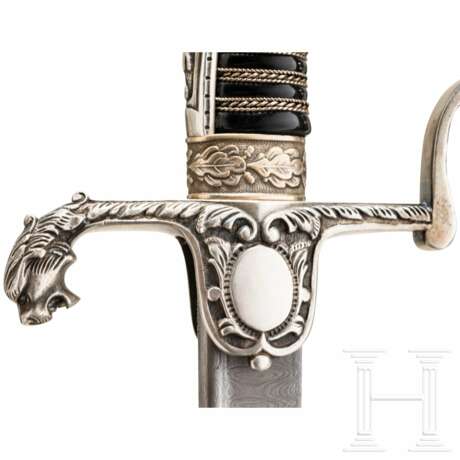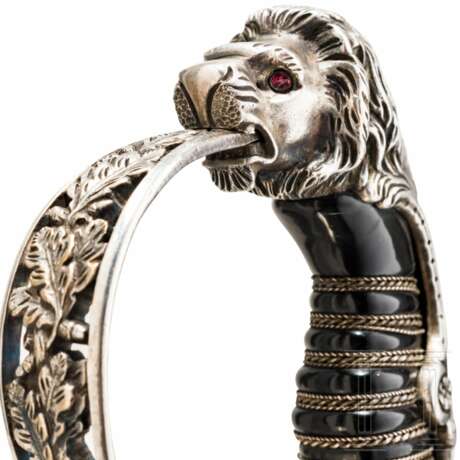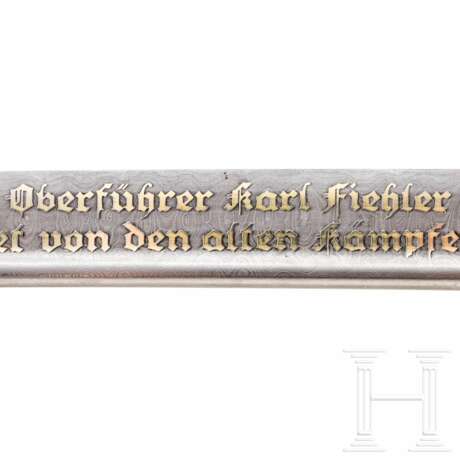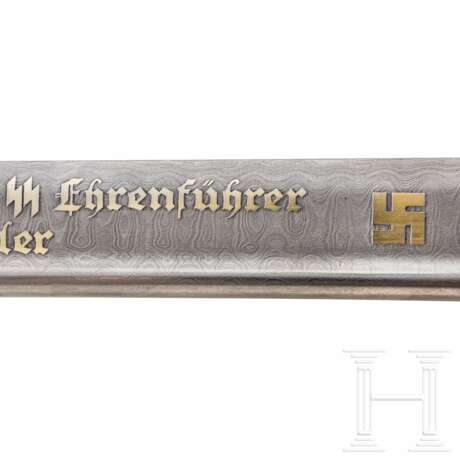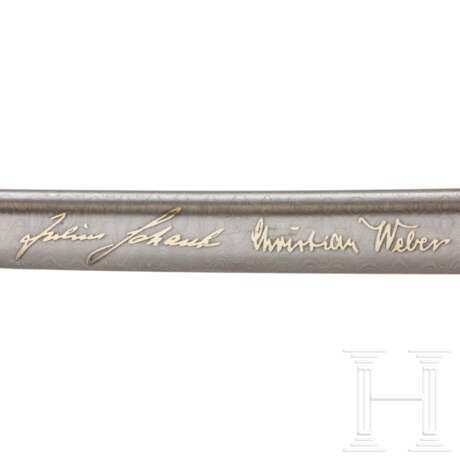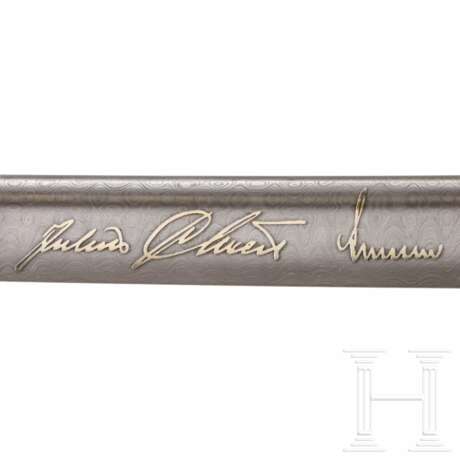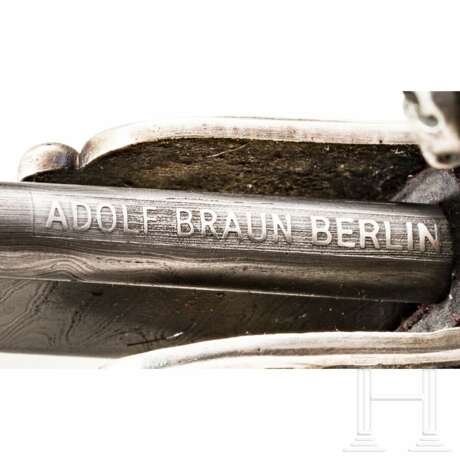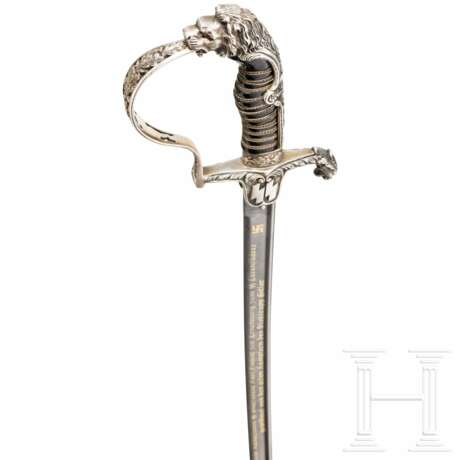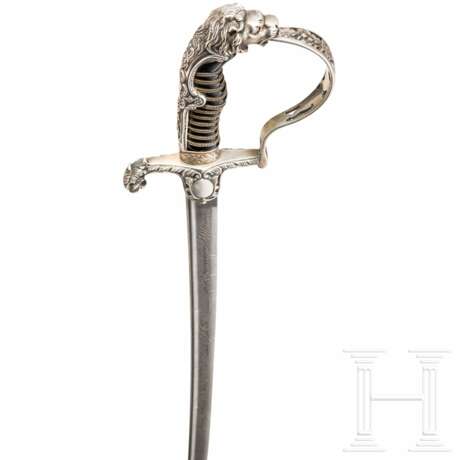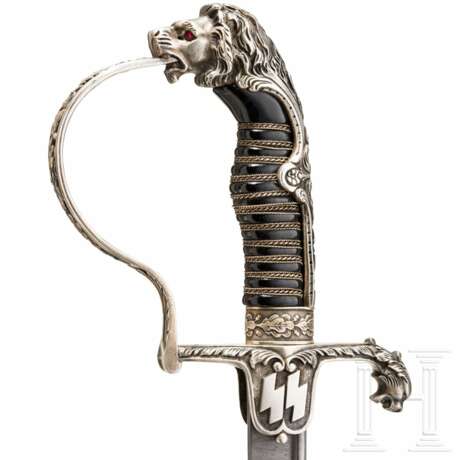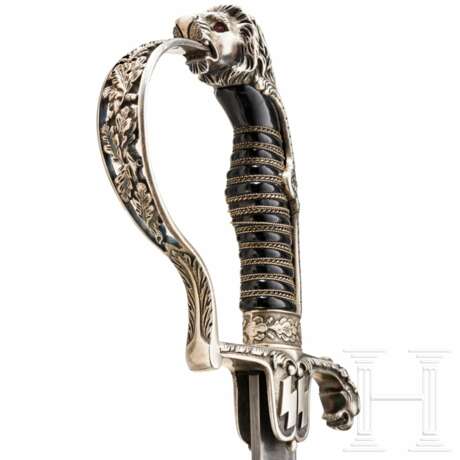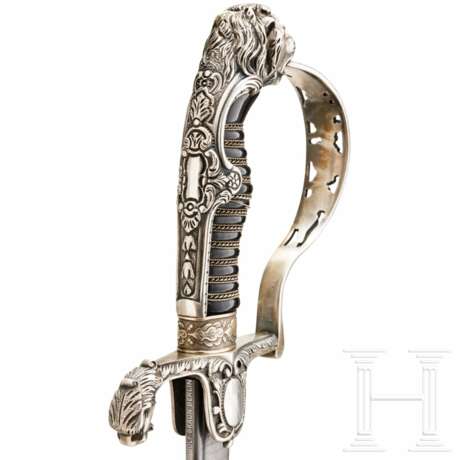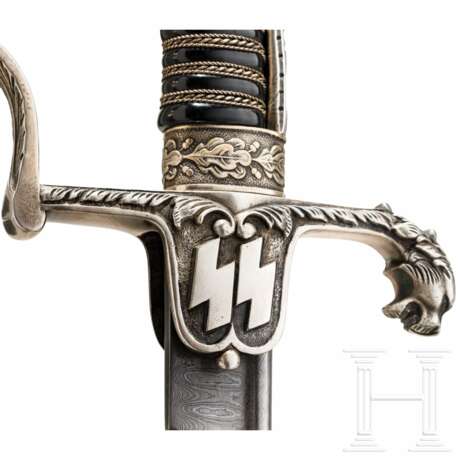Karl Fiehler (1895 - 1969) - SS-Löwenkopfsäbel in Prunkausführung, Geschenk der "alten Kämpfer des Stoßtrupps Hitler" zu seiner Ernennung zum SS-Ehrenführer am 27. Januar 1934
29.04.2025 10:00UTC +01:00
Classic
Sold
130000EUR € 130 000
| Auctioneer | Hermann Historica |
|---|---|
| Event location | Germany, Grasbrunn / München |
| Buyer Premium | 25 % |
Archive
The auction is completed. No bids can be placed anymore.

ID 1414435
Lot 1820 | Karl Fiehler (1895 - 1969) - SS-Löwenkopfsäbel in Prunkausführung, Geschenk der "alten Kämpfer des Stoßtrupps Hitler" zu seiner Ernennung zum SS-Ehrenführer am 27. Januar 1934
Luxusfertigung von Alcoso in Solingen, im Auftrag der Firma Adolf Braun in Berlin. Die Steckrückenklinge mit Schör aus hochwertig geschmiedetem Banddamast, vermutlich von Carl Wester, am Klingenrücken geätzte Fournisseurbezeichnung "Adolf Braun, Berlin", die Fehlschärfe ohne Herstellerlogo. In der vorderen Hälfte beidseitig erhabene und vergoldete Inschriften, terzseitig "Ihrem Kameraden SS Oberführer Karl Fiehler zur Ernennung zum SS Ehrenführer gewidmet von den alten Kämpfern des Stoßtrupp Hitler" zwischen zwei en suite gefertigten Hakenkreuzen, quartseitig die Unterschriften der schenkenden Kameraden "Julius Schaub - Christian Weber - Julius Schreck - Amann - Jakob Grimminger - E.Maurice". Kräftiges und versilbertes Neusilbergefäß, der Löwenkopfknauf mit zwei eingesetzten roten Glasaugen, der durchbrochen gearbeitete Bügel mit Eichenlaubdekor, der quartseitige Parierlappen mit großen erhabenen SS-Runen, der terzseitige mit vakanter Monogrammkartusche. Die Parierstange in einem Löwenkopf auslaufend. Schwarzer Kunststoffgriff mit Drahtwicklung. Schwarz lackierte Stahlscheide mit Fehlstellen um den Tragering. Länge des Säbels 96,5 cm, Gesamtlänge 99 cm.
Beeindruckender sowie bedeutender Geschenksäbel, der auf dem Modell Nr. 113 von Alexander Coppel (Alcoso) beruht. Vgl. Thomas M. Johnson, German Swords of World War II, Band 2, auf den Seiten 442 bis 448 mit Abbildungen dieses Modells in weniger prunkvoller Ausführung, aber mit den hierfür typischen tropfenförmigen Parierlappen mit Kugelabschluss.
Der im Mai 1923 als Leibgarde gegründete "Stoßtrupp Adolf Hitler" wurde zu Beginn von Josef Berchtold und Julius Schreck kommandiert, Adjutant war Emil Maurice. Zu den frühen Mitglieder zählten neben Schaub, Weber oder Grimminger ab dem 6. November 1923 auch Karl Fiehler. Am 8. November 1923, als Hitler im Bürgerbräukeller seinen Putsch verkündete, sicherte der Stoßtrupp den Saal, stürmte anschließend die Redaktion der "Münchner Post", nahm den Redakteur und sozialdemokratischen Stadtrat Erhard Auer als Geisel und war am Folgetag maßgeblich am Marsch auf die Feldherrnhalle beteiligt. Die 38 Mitglieder wurden 1924 hierfür zu Festungshaft in Landsberg verurteilt.
Karl Fiehler, Lt. d.R im 1. Weltkrieg, trat schon 1920 der NSDAP bei, wurde nach verbüßten 15 Monaten Festungshaft 1924 ehrenamtlicher Stadtrat in München, trat nach der Neugründung der Partei am 1.6.1925 erneut mit der Mitgliedsnummer "37" bei und wurde Fraktionsleiter. Nach der Machtergreifung Hitlers ernannte Adolf Wagner als bayr. Innenminister am 22. März 1933 Fiehler zum kommissarischen Ersten Bürgermeister Münchens und am 20. Mai 1933 wurde er bis Kriegsende Oberbürgermeister. Zudem erhielt er im Juli 1933 den Rang eines Standartenführers und im Dezember 1933 den eines Oberführers der SS. Schon am 27. Januar 1934 erfolgte die nächste Beförderung mit der Ernennung zum SS-Ehrenführer des Oberabschnittes Süd im Range eines SS-Gruppenführers. Zudem war er seit 1935 auch Reichsleiter der NSDAP und ab Januar 1942 SS-Obergruppenführer sowie Mitglied des Stabes RFSS.
1949 wurde er von der Hauptspruchkammer München zu zwei Jahren Arbeitslager verurteilt und starb 1969 in Dießen am Ammersee.
Karl Fiehler (1895 - 1969) - a magnificent SS lion's head sabre, gift of the "alte Kämpfer des Stroßtrupps Hitler" on the occasion of his appointment to SS Ehrenführer on 27 January 1934
Karl Fiehler (1895 - 1969) - a magnificent SS lion's head sabre, gift of the "alte Kämpfer des Stroßtrupps Hitler" on the occasion of his appointment to SS Ehrenführer on 27 January 1934
Deluxe weapon manufactured by Alcoso in Solingen, commissioned by the company Adolf Braun in Berlin. The pipe-backed blade with yelmen of high-quality forged twist Damascus steel, probably by Carl Wester, the back of the blade with etched supplier’s inscription "Adolf Braun, Berlin", the ricasso without maker’s mark. The front half with raised and gilt inscription on both sides, on the obverse inscription (tr.) "Dedicated to their comrade SS Oberführer Karl Fiehler on his appointment to SS Ehrenführer, by the ‘alte Kämpfer des Stoßtrupp Hitler’" between two swastikas manufactured en suite, on the reverse the signatures of the donating comrades "Julius Schaub - Christian Weber - Julius Schreck - Amann - Jakob Grimminger - E.Maurice". Sturdy, silver-plated hilt of nickel silver, the lion’s head pommel with two inserted red glass eyes, the openwork knuckle bow with oak leaf décor, the reverse languet with large raised SS runes, the obverse one with vacant monogram cartouche. The quillons terminating in a lion’s head. Black grip of synthetic material with wire warp. Steel scabbard lacquered in black with flaws around the suspension ring. Length of sabre 96.5 cm, overall length 99 cm.
Impressive and significant presentation sabre based on the model number 113 by Alexander Coppel (Alcoso). Cf. Thomas M. Johnson, German Swords of World War II, vol. 2, on pages 442 to 448 with illustrations of this model in less magnificent workmanship, but with the characteristic drop-shaped languet with ball finial.
The "Stoßtrupp Adolf Hitler" established in May 1923 as life guards was initially commanded by Josef Berchtold and Julius Schreck, with Emil Maurice as adjutant. Among the early members were Schaub, Weber and Grimminger and, as of 6 November 1923, also Karl Fiehler. On 8 November 1923, when Hitler announced his Beer Hall Putsch, the Stoßtrupp secured the hall, then barged into the editorial office of the "Münchner Post" newspaper, took the editor and Social Democrat Erhart Auer, member of the City Council, hostage and played a major part in the march on the Feldherrnhalle the next day. For this action, the 38 members were sentenced to fortress detention in Landsberg in 1924.
Karl Fiehler, reserve lieutenant in World War I, joined the NSDAP as early as 1920, became honorary member of the City Council in 1924 after having served 15 months of fortress imprisonment, rejoined the party after its re-formation on 1 June 1925 with his previous membership number "37" and became chairman of the parliamentary group. After Hitler seized control of the government, Adolf Wagner as Bavarian Minister of the Interior appointed Fiehler provisional First Mayor of Munich on 22 March 1933, who became Lord Mayor on 20 May 1933 until the end of the war. In addition, he was awarded the rank of Standartenführer in July 1933 and of SS Oberführer in December 1933. As early as 27 January 1934 he was promoted to SS Ehrenführer of the SS Higher Section South in the rank of SS Gruppenführer. Furthermore, he was Reichsleiter of the NSDAP since 1935 and SS-Obergruppenführer and member of the staff of the RFSS as of January 1942.
In 1949, he was sentenced to two years of labour camp by the Hauptspruchkammer (main denazification court) and died in Dießen at Lake Ammersee in 1969.
Condition: I - II
| Auction house category: | Waffen-SS and general SS |
|---|
| Auction house category: | Waffen-SS and general SS |
|---|
| Address of auction |
Hermann Historica Bretonischer Ring 3 85630 Grasbrunn / München Germany | ||||||||||||||
|---|---|---|---|---|---|---|---|---|---|---|---|---|---|---|---|
| Preview | |||||||||||||||
| Phone | +49 (0)89 5472 649 0 | ||||||||||||||
| Fax | +49 (0)89 5472 64999 | ||||||||||||||
| Buyer Premium | 25 % | ||||||||||||||
| Conditions of purchase | Conditions of purchase | ||||||||||||||
| Business hours | Business hours
|

